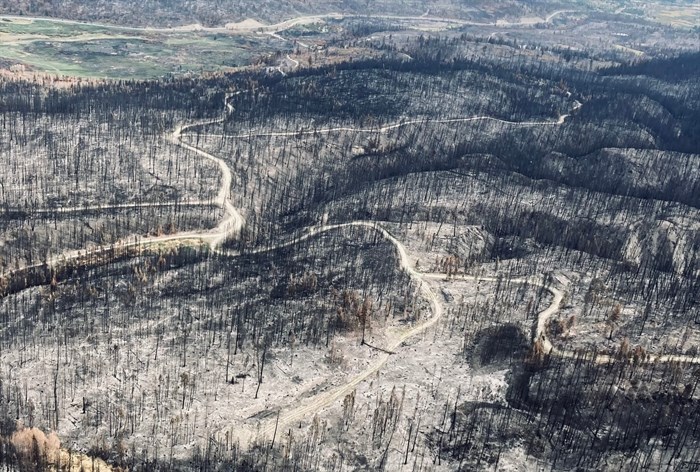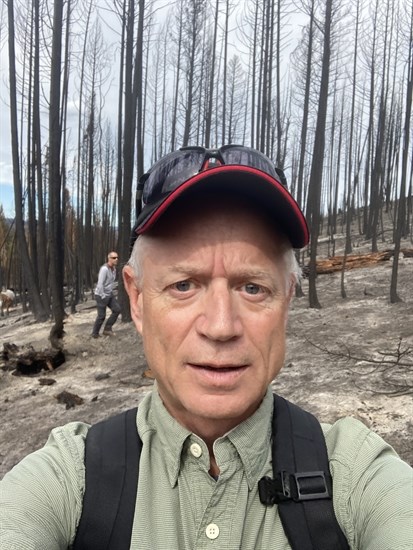
Burned forest in the Interior.
Image Credit: SUBMITTED/Mike Madill
September 28, 2021 - 6:30 AM
An ongoing program with the Ministry of Forests is recapturing carbon emissions in the Interior’s burned zones and will create natural wildfire breaks.
In the past, forest technical advisor Mike Madill said replanting was focused on helping loggers harvest faster but that has changed.
For example, aspen, which isn’t worth much for loggers, will be planted in areas of the Tremont Creek, Sparks Lake and White Rock Lake wildfires because it serves as a natural fire break.
“Foresters would try and get rid of the aspen, we’d call it a weed species (if) you just want conifers because they were valuable for the logging… and we’re not doing that now,” he said.
This is the first time they’ll be planting aspen, Madill said, adding it also contributes to the biodiversity of a forest.
READ MORE: Kamloops Fire Centre sees record-breaking number of hectares burned this year
When conducting flyovers of the Interior’s burned areas recently, Madill saw where aspen acted as a natural fire break after it burned through a pine block.
Starting in 2017, as part of the Forest Carbon Initiative branch, Madill has been reforesting areas to sequester carbon.
“We’re replanting these areas so they’ll suck in CO2 and give out oxygen,” he said.
Roughly 70% of forests regenerate naturally but some species like douglas fir need a little help to regrow. In recent weeks, surveys have been conducted in the fire areas. Seeds are sourced from the zones, and sent to nurseries. After a year and a half, they’re ready to be planted, he said.
Aspen, douglas fir, lodgepole pine, yellow pine, and larch are grown in styrofoam blocks across Alberta, B.C. and Saskatchewan, and will be planted in the Interior wildfire areas starting in 2023, he said. Sites planted can help forests grow back roughly 30 years faster, he said.
Roughly half of the trees that will be planted are douglas fir, he said, and only 10% of the areas burned will be replanted.

Ministry of Forests forest technical advisor Mike Madill
Image Credit: SUBMITTED/Mike Madill
Some trees will be planted inside of the timber harvesting lands, and in roughly 70 years, they can be logged, but they’re also reforesting in old growth and wildfire areas for the benefit of the environment, he said.
This year, 25 million trees have been sewn in areas previously burned by wildfires in B.C. Tree planting is conducted in the spring but those planted in the Interior this past spring at the end of the season had a high mortality rate because of the heat wave, he said.
Crews will be working to replant areas in the 2021 wildfires for years to come, he said.
Randy Spyksma, community forests manager with the Logan Lake Community Forest, an organization overseen by the district, said this fall they’ll be looking for opportunities to salvage timber close to the community as the value of the wood can help cover the costs of logging and reforestation.
North of the town, the Tremont Creek wildfire burned the Logan Lake trail system north, so the community forest has been working to remove danger trees to reopen them next season, he said.
The Tremont Creek wildfire burned up into the town’s jurisdiction this past summer.
READ MORE: Logan Lake has written the Fire Smart playbook for other cities, towns to follow
Where logs are not valuable, provincial funding may be needed to help complete the work, Spyksma said.
The community forest also supports firesmart work throughout the district, he said.
“I think community forests are a really effective way for communities to become more involved in forest management around a community and that can be associated with trails or with firesmart or with managing watersheds,” he said.
To contact a reporter for this story, email Carli Berry or call 250-864-7494 or email the editor. You can also submit photos, videos or news tips to the newsroom and be entered to win a monthly prize draw.
We welcome your comments and opinions on our stories but play nice. We won't censor or delete comments unless they contain off-topic statements or links, unnecessary vulgarity, false facts, spam or obviously fake profiles. If you have any concerns about what you see in comments, email the editor in the link above.
News from © iNFOnews, 2021